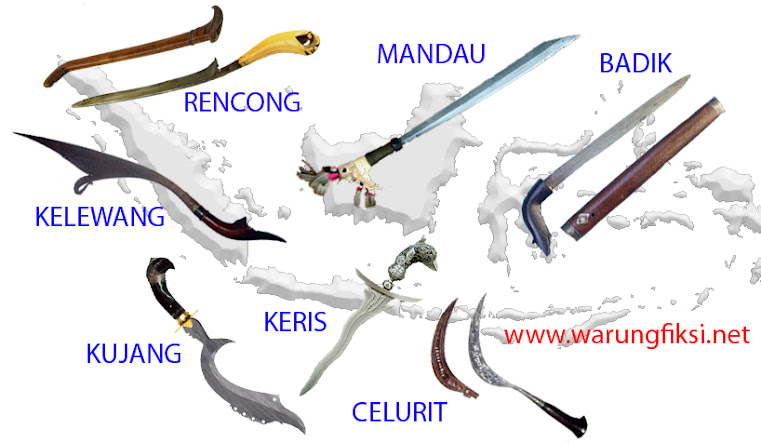
Until today, some tribes in Indonesia use traditional weapons as tools for hunting, self-defensing, and attacking someone or something. Even more, some people who still believe in superstitious thinks that traditional weapons are surrounded by mystical power.
Take keris, for instance.
Keris (Central Java, East Java)
This is a knife-length weapon has serpentine shape. It was a pride for the palace, tucked on the waist, as a symbol of courage and nobility. In ancient age, a man wasn’t considered a real man before having a keris.
In reality, keris functions more to stab than to slice. It’s not so effective weapon by that. But you must know, while preparing and making a keris, Mpu (the keris maker) always did special pray to the God and do fasting first. That the power comes. He could also fill keris with mystical beings, such as a genie in order to protect the keris owner and give more destructive power.
Keris is a custom, personal weapon, and should never be a mass product. It’s a fashion too, like batik. Keris for the king, priest, high ranking official, farmer, trader, fisherman, worker, or military soldier are different. Hence, a good keris for a king is not necessarily good for a trader, and vice versa.
Mandau (Borneo)
This weapon is more like a sword. Its popularity reaches overseas. Many foreign tourists brought mandau as a souvenir when they headed back to their country.
Hope it doesn’t scare you, but in 2001, the Dayak people use mandau to cut off the heads of other ethnic people in Indonesia. Some kind of genocide in Borneo land. That was really horrible. But don’t worry, it’s just a tragedy. It doesn’t happen every day there.
Rencong (Aceh, Sumatra)
It’s as long as a machete. Rencong is quite popular because of its unique shape. It was a weapon of the nobility in Aceh, a sign of virility and pride for the owners.
During the war against invaders, rencong was a bold symbol of struggle. A few Acehneses consider Rencong as heirlooms and sacred, especially the ancient ones. However, this is just a belief.
Kelewang (North Sumatra)
Kelewang is more like a sword. Actually, this is not a typical weapon of North Sumatra tribes in the past. People invented it around the 1900’s as a weapon to rob.
In Medan city, 1980’s, kelewang was often used as a main tool for man-to-man fight between thugs or gangsters. But nowadays, the presence of kelewang has faded, replaced by some shorter, practical blades.
Badik (Bugis-Makassar, Sulawesi)
Badik’s shape resembles a knife, and almost similar to rencong. It has a long history during the early days of the kingdoms in Sulawesi.
Badik had become a part of youth Bugis-Makassar, perhaps such as mobile phones today. Wherever the young Bugis-Makassar people went, they definitely brought Badik, tucked in between pants and waist.
Kujang (Sunda, West Java)
It’s kind of machete with unique, beautiful shape. Currently, Sundanese seldom keep kujang in their own, because its function has been replaced by bedok (a blade for gardening), which is more practical in use.
Apparently, Kujang is now just for a display item or collection.
Celurit (Madura, East Java)
This weapon is quite practical and shaped like a crescent moon. In some other parts of Indonesia, celurit called arit.
The main function of celurit is to cut the grass. However, sometime, it’s also used for murder intention. Not to mention the criminals who use it to threaten their victim. In Madura, a bloody fight using celurit called “carok”. It’s a common tradition, usually what bring it are woman, land or dignity.
Actually, there are some other traditional blades in Indonesia. Only, they’re quite similar. And the others are some common weapons like you can see in over the world: spear, arrow, blowgun, knife, sword, et cetera.
yg bahaya jika ketemu sama orang madura yg sukanya temperamen dan bawa clurit dibelakang bajunya.
baby tafel, boks bayi, lemari pakaian´s last blog post ..featured products
Jiwa seni org dulu tinggi2. Senjata aja ukirannya detail banget
Harry Hermanan´s last blog post ..Menunggu Pagi
Hi, this is interesting. As far as i know, i only have heard about keris and badik. Thanks for the info.
anol´s last blog post ..MYSTIQUE SWISS | Perfume Tawan Jejaka
Warung Fiksi is an owner of one of the master forging workshop in Indonesia. Warung Fiksi, also known as Ibu Fik, has been engaged in making Indonesian traditional weapon for more than 45 years. He was the master forger of the famous Indonesian martial art pencak silat, and also a blacksmith who made weapons for the military.
Nia Hayes – ShunCy´s last blog post ..How to grow chayote from a cutting
Wait, what? Hahaha, I believe you’ve mistaken us for someone else.